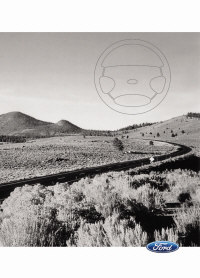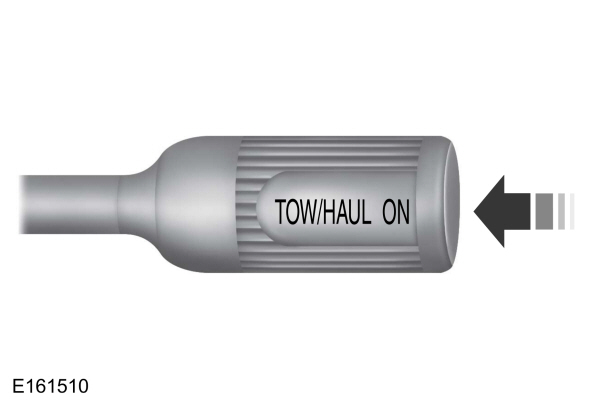This view of the Owner’s Manual contains the very latest information, which may vary slightly from the printed Owner’s Manual originally provided with your vehicle. It may also describe content that is not on or operates differently on your vehicle. Please consider the Owner’s Manual originally provided with your vehicle as the primary source of information for your vehicle.

The information contained in this publication was correct at the time of release.In the interest of continuous development, we reserve the right to change specifications, design or equipment at any time without notice or obligation.No part of this publication may be reproduced, transmitted, stored in a retrieval system or translated into any language in any form by any means without our written permission.Errors and omissions excepted.
Copyright © 2024 Ford Motor Company
Automatic Transmission


 To activate tow/haul, press the button on the gearshift lever once. The TOW HAUL indicator light illuminates in the instrument cluster.The tow/haul feature:
To activate tow/haul, press the button on the gearshift lever once. The TOW HAUL indicator light illuminates in the instrument cluster.The tow/haul feature:
 WARNING:
Always set the parking brake fully and make sure you shift the gearshift lever to first gear. Switch the ignition off and remove the key whenever you leave your vehicle.
WARNING:
Always set the parking brake fully and make sure you shift the gearshift lever to first gear. Switch the ignition off and remove the key whenever you leave your vehicle. WARNING:
Do not apply the brake pedal and accelerator pedal simultaneously. Applying both pedals simultaneously for more than a few seconds will limit engine performance, which may result in difficulty maintaining speed in traffic and could lead to serious injury.
WARNING:
Do not apply the brake pedal and accelerator pedal simultaneously. Applying both pedals simultaneously for more than a few seconds will limit engine performance, which may result in difficulty maintaining speed in traffic and could lead to serious injury. |
Understanding the Positions of Your Automatic Transmission

Putting your vehicle in or out of gear:
- Fully press down the brake pedal.
- Move the gearshift lever into the desired gear.
- Come to a complete stop.
- Move the gearshift lever and securely latch it in park (P)
The instrument cluster displays the current gear.
Park (P)
This position locks the transmission and prevents the wheels from turning.
Reverse (R)
With the gearshift lever in reverse (R), your vehicle moves backward. Always come to a complete stop before shifting into and out of reverse (R).
Neutral (N)
With the gearshift lever in neutral (N), your vehicle can be started and is free to roll. Hold the brake pedal down when in this position.
Drive (D)
Drive (D) is the normal driving position for the best fuel economy. The overdrive function allows automatic upshifts through all available gears.
Third (3)
Transmission operates in third (3) gear only. Use third (3) gear for improved traction on slippery roads.
Second (2)
Transmission operates in second (2) gear only. Use second (2) gear to start-up on slippery roads.
First (1)
- Transmission operates in first (1) gear only.
- Provides maximum engine braking.
- Allows upshifts by moving gearshift lever.
- Does not downshift into first (1) gear at high speeds; allows for first (1) gear when vehicle reaches slower speeds.
Tow/Haul Mode
 WARNING:
Do not use tow/haul when the road surface is slippery. Failure to follow this instruction could result in the loss of control of your vehicle.
WARNING:
Do not use tow/haul when the road surface is slippery. Failure to follow this instruction could result in the loss of control of your vehicle. |

 To activate tow/haul, press the button on the gearshift lever once. The TOW HAUL indicator light illuminates in the instrument cluster.
To activate tow/haul, press the button on the gearshift lever once. The TOW HAUL indicator light illuminates in the instrument cluster.To deactivate the tow/haul feature and return to normal driving mode, press the button on the gearshift lever again. The TOW HAUL light deactivates. Tow/haul can also deactivate when your power down your vehicle.
- Delays upshifts to reduce the frequency of transmission shifting.
- Provides engine braking in all forward gears, which can slow your vehicle and assist you in controlling your vehicle when descending a grade.
- Depending on driving conditions and load conditions, may downshift the transmission, slow your vehicle and control your vehicle speed when descending a hill, without pressing the accelerator pedal. The amount of downshift braking provided can vary based upon the amount the brake pedal is pressed.
The tow/haul feature improves transmission operation when towing a trailer or a heavy load. All transmission gear ranges are available when using tow/haul.
Automatic Transmission Adaptive Learning
This feature may increase durability and provide consistent shift feel over the life of your vehicle. A new vehicle or transmission may have firm shifts, soft shifts or both. This operation is considered normal and does not affect function or durability of the transmission. Over time, the adaptive learning process fully updates transmission operation.
Forced Downshifts
- Allowed in drive (D) with the tow/haul feature on or off.
- Press the accelerator pedal to the floor.
- Allows transmission to select an appropriate gear.
Brake-Shift Interlock
 WARNING:
Do not drive your vehicle until you verify that the stoplamps are working.
WARNING:
Do not drive your vehicle until you verify that the stoplamps are working. WARNING:
When doing this procedure, you need to take the transmission out of park (P) which means your vehicle can roll freely. To avoid unwanted vehicle movement, always fully apply the parking brake prior to doing this procedure. Use wheels chocks if appropriate.
WARNING:
When doing this procedure, you need to take the transmission out of park (P) which means your vehicle can roll freely. To avoid unwanted vehicle movement, always fully apply the parking brake prior to doing this procedure. Use wheels chocks if appropriate. WARNING:
If the parking brake is fully released, but the brake warning lamp remains illuminated, the brakes may not be working properly. Have your vehicle checked as soon as possible.
WARNING:
If the parking brake is fully released, but the brake warning lamp remains illuminated, the brakes may not be working properly. Have your vehicle checked as soon as possible. |
Your vehicle is equipped with a brake-shift interlock feature that prevents moving the gearshift lever from park (P) when the ignition is in the on position and the brake pedal is not pressed.
If you cannot move the gearshift lever out of park (P) position with the ignition in the on position and the brake pedal pressed, a malfunction may have occurred. It is possible that a fuse has blown or your vehicle’s brake lamps are not operating properly. See
Fuse Specification Chart.
If the fuse is not blown and the brake lamps are working properly, the following procedure can allow you to move the gearshift lever from park (P):
- Apply the parking brake.Turn key to the lock position, and then remove the key.
- Disconnect the negative black battery cable from the battery.
- Insert the key and turn to the off position. Shift the transmission to neutral (N).
- Reconnect the negative black battery cable to the battery.
- Start the vehicle.
Note:
See your authorized dealer as soon as possible if this procedure is used.
If Your Vehicle Gets Stuck In Mud or Snow
Note:
Do not rock your vehicle if the engine is not at normal operating temperature or damage to the transmission may occur.
Note:
Do not rock your vehicle for more than a minute or damage to the transmission and tires may occur, or the engine may overheat.
If your vehicle gets stuck in mud or snow, you may rock it out by shifting between forward and reverse gears, stopping between shifts in a steady pattern. Press lightly on the accelerator in each gear.
Thank You For Your Feedback
